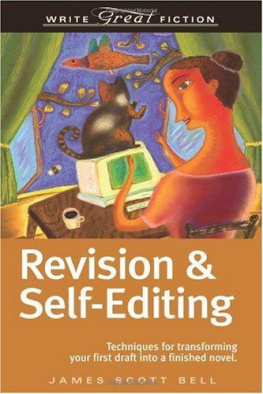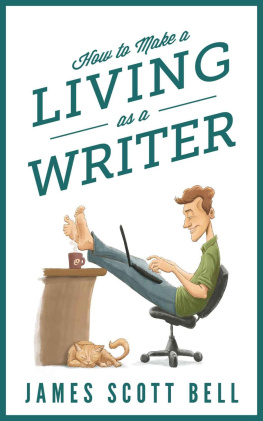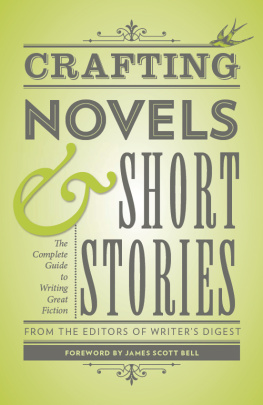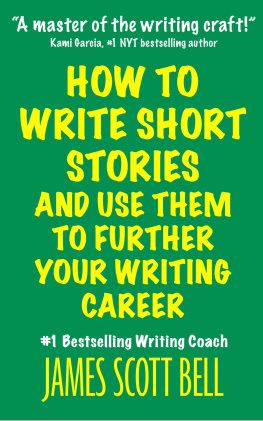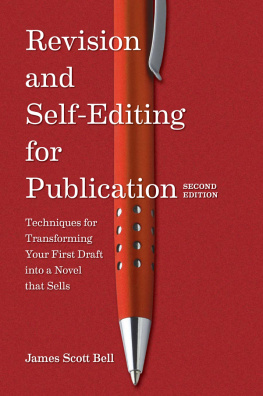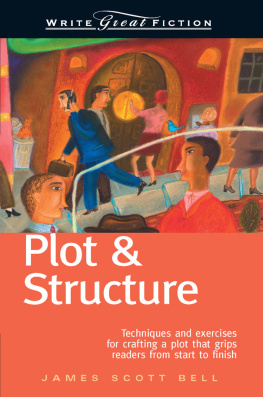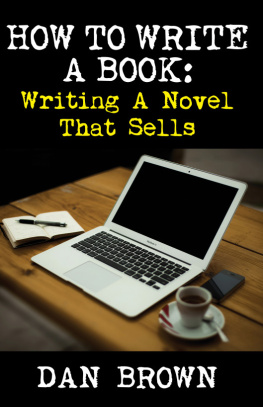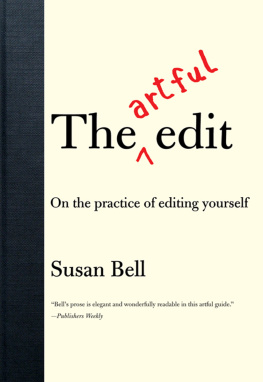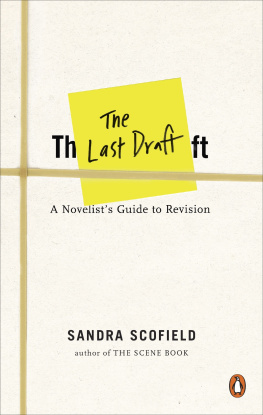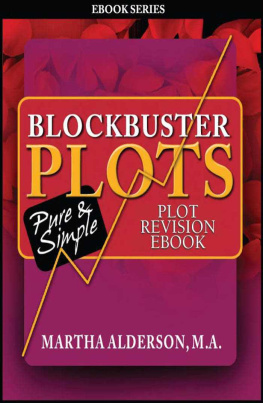INTRODUCTION:
On Becoming a Writer
Part One: Self-Editing
CHAPTER ONE:
A Philosophy of Self-Editing CHAPTER TWO:
Characters
CHAPTER THREE:
Plot & Structure
CHAPTER FOUR:
Point of View
CHAPTER FIVE:
Scenes
CHAPTER SIX:
Dialogue
CHAPTER SEVEN:
Beginnings, Middles & Ends
CHAPTER EIGHT:
Show vs. Tell
CHAPTER NINE:
Voice & Style
CHAPTER TEN:
Setting & Description
chapter eleven:
Exposition
chapter twelve:
Theme
Part Two: Revision
chapter thirteen:
A Philosophy of Revision
chapter fourteen:
Before You Revise
chapter fifteen:
The First Read-Through
chapter sixteen:
The Ultimate Revision Checklist
Character
Plot
The Opening
Middles
Endings
Scenes
Exposition
Voice, Style & Point of View
Setting & Description
Dialogue
Theme
The Polish
epilogue
The Trick That Cannot Be Explained appendix
Exercise Answers
index
[ ON BECOMING A WRITER ]
About ten years ago, losing all rationality, I decided to take up golf.
In those first couple of years I bought books and tapes and subscribed to the magazines. I was sure with enough study and practice I'd be shooting eighty soon.
Those of you who golf are laughing now. But I wasn't laughing. I also wasn't having fun. I thought the best course might be to chuck the whole thing and take up needlepoint.
What had happened was I'd pumped my head full of techniques and tips and reminders and visuals. And I was always trying to remember every one of them as I played. You know, like the twenty-two steps to perfect putting and the thirteen most important things to remember at point of impact.
Insanity.
Just before flinging my clubs into the Dumpster, I met a golf teacher named Wally Armstrong. Wally is well known for his teaching skills, using simple household itemslike brooms and coat hangers and spongesto implant the feel of various aspects of the game.
If you're thinking about the swing while you're playing, Wally says, you're lost. You'll tense up. You will find yourself in a labyrinth of theory, with no way out.
But if you have the feel ingrained, you can forget about all the technical stuff and just play. Your body, trained in the feel, does its thing.
Wally was right, and I've been enjoying the game ever since. I don't shoot below eighty yet, but I have fun and don't embarrass myself.
Or rarely, that is.
Now, it seems to me that writing good fiction is a lot like playing good golf. With the same dangers, too. There is no end of books and articles teaching various aspects of the craft. But if you are trying to think of them
all as you write , you'll tense up. You won't write, as Brenda Ueland puts it, "lively and rollickingly." Plus, it won't be any fun. You'll feel like throwing your pages in the Dumpster (okay, many writers feel this way anyway, but that's just an occupational hazard).
So what I want you to be able to do is feel your writing. When you sit down for a writing stint, don't think about technique. Just write. Let it flow. Later, you'll come back to it and revise. This book will show you how.
When you're not writing, keep learning the craft. Increase the storehouse of knowledge. Analyze your work with techniques in mind.
But when you're writing, write. Trust that the techniques you are learning will flow out naturally.
When they don't, you can learn to see where the problems are.
That's what self-editing and revision are all about. Learning, feeling, writing, analyzing, correcting, and making your writing better.
Over and over.
The rest of your life.
That's right. You're a writer, not someone who wants to write some books. You are a person of the craft, a dues-paying member of the club.
So pay your dues by doing the following:
1] READ
You can't be a great fiction writer without reading. A lot. All kinds of novels. And poetry and nonfiction.
Each time you read a book, the flow and rhythm of the writing implants itself in your brain. When it's good writing, when you respond to it, it goes in the good file. When it's not-so~good writing, you'll sense it and put in under bad.
You'll learn about plot and story construction and character building. Your storehouse will fill up and be ready for you when you're in need.
Be self-directed in your reading. In Plot & Structure I explained a process for learning plot so you'll begin to feel it in your marrow. Here's a brief recap:
Step one: Get half a dozen novels of the type you want to write.
Step two: Read the first book for pleasure and think about it afterward. What did you like about it?
Step three: Now read the second book and take some time to think about it, too.
Step four: Read the next four books in the same fashion.
Step five: Now go back to book one and, on index cards, mark each scene. Number them, then give us the setting, what the scene is about, and what, if anything, makes you want to read on.
Step six: Repeat this drill for the all the books.
Step seven: Beginning with any stack of cards, go through them quickly, remembering the book, giving yourself a movie in the mind.
Step eight: Do the same with the other stacks of index cards.
What this exercise does is burn plot and structure into your mind. Keep those cards and review them periodically.
With some modification, you can do the same thing for any aspect of the fiction craft. See #4 below. So read.
2] RECORD YOUR OBSERVATIONS
When I was first trying to figure out this writing thing, I got very excited every time I spotted something in a novel that worked. Or got a technique from a writing book that made a little lightbulb go off in my head.
Whenever I learned something I'd jot it down. Sometimes on paper, sometimes on a napkin, whatever was handy. I still have a stack of these notes, carefully preserved in a large envelope. I look at them from time to time just to get my juices flowing again.
For example, here's one of my early notes, with the heading "READ ON TECHNIQUES!"
1] Action, peril, chase, jeopardythen leave the scene before resolution. (See Watchers by Koontz, chapter one.)
2] Mention a portent, then cut to another scene. (See The Dead Zone by King, end of first scene.)
3] Hintpull back.
4] The moment of decision, then leave the scene.
I still get a charge out of this. I was trying to learn how to write a novel readers couldn't put down, and these were like finding gold nuggets.
Make a habit of recording the things you learn, every time something comes through. Don't let any insight slip away.
3] ASSIMILATE
When you learn a technique from a writing book that looks promising, practice it. Write a scene that uses the technique. Get it out of your head and onto the page.
When you do this, you're assimilating the information. It's going from information to transformation, making you into a better writer. It soaks into your memory, the way a golf technique that's felt soaks itself into your muscles.
You will know, absolutely, that your writing is getting better and better. It's an intoxicating feeling. As Ray Bradbury has said, stay drunk on writing so reality doesn't destroy you.
4] CONTINUE TO LEARN
Don't ever stop your growth process as a writer. Even after publication.
No, especially after publication. You want to keep publishing, and you do that by trying to make each new book a little better than the last. So improve.
In fact, be systematic about improving. Create your own "plan of attack" for strengthening your work.
Several novels into my career I stepped back and assessed where I was in my writing. I knew I was strong on plot but felt I wasn't strong enough on character. I wanted to go deeper with my story people. So I sat down and created a plan, with these steps:
Next page
